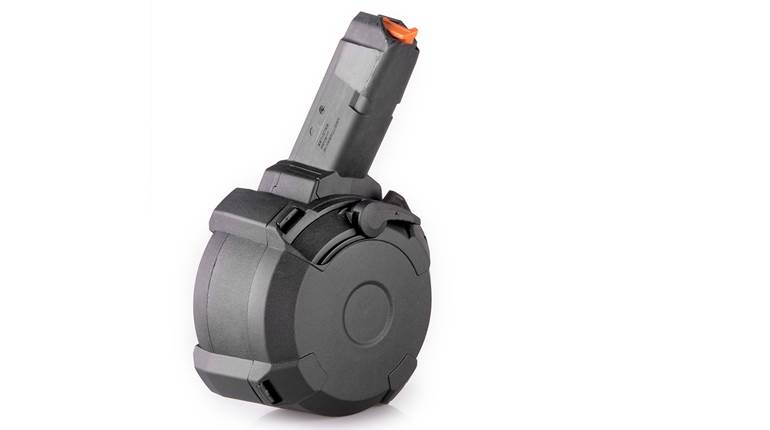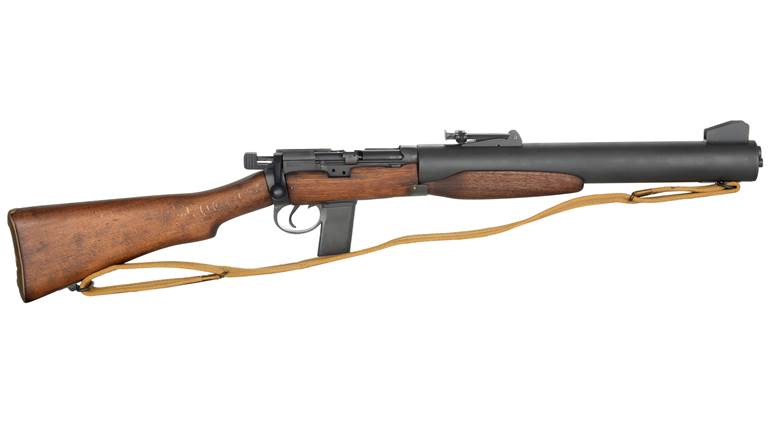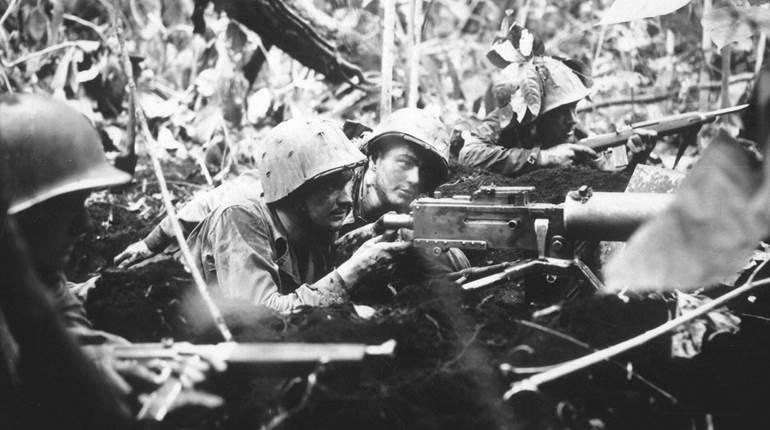
“They were good guns, especially for the man who couldn’t shoot. And although they were much too heavy—I never wanted to carry one myself—it always made me feel good to have one or two close at hand.” - Lt. Col John B. George.
 The early “militarized” Thompson guns featured a simplified rear sight and a horizontal front grip, even though they retained the compensator on the muzzle and the ability to use a drum magazine. Fort Sam Houston, September 1942. NARA.
The early “militarized” Thompson guns featured a simplified rear sight and a horizontal front grip, even though they retained the compensator on the muzzle and the ability to use a drum magazine. Fort Sam Houston, September 1942. NARA.
When Brig. Gen. John T. Thompson conceived his famous submachine gun, the Allies were locked in the meat-grinding stalemate of World War I. At the beginning of 1918, both sides were hard at work to develop infantry weapons with enough firepower to break the deadlock. Before the end of the war, the Germans were able to deploy their own MP-18 submachine gun (9 mm), using a 32-round drum magazine. Small numbers of the MP-18 made it to the front, not enough to make a difference, but enough to be noticed.
General Thompson’s proposed “trench broom” was thought to give Allied infantrymen a significant firepower advantage and help prepare the way for a breakthrough in a grand offensive in 1919. As it turned out, the Thompson gun wasn’t ready, and the grand offensive of 1919 never happened. The Kaiser’s abdication and Germany’s collapse mercifully ended the war on Nov. 11, 1918.
 The Island of Death: The Marine Corps used many Thompson guns, often equipped with 50-round drum magazines, on Guadalcanal. NARA.
The Island of Death: The Marine Corps used many Thompson guns, often equipped with 50-round drum magazines, on Guadalcanal. NARA.
In 1921, when the Thompson Model 1921 became available, most of the world’s militaries had moved on, pulled back or were simply out of money. While the new Thompson gun was interesting, it was also expensive (about $200 a piece), and even worse, it was unproven. Unable to find significant government buyers, the Thompson gun became an oddity, and its early users were often outside the law. There were no laws governing fully automatic firearms during the 1920s, and the Thompson found its way into the hands of several high-profile criminals, and there was considerable negative media attention surrounding General Thompson’s invention.
 The Coast Guard: In the early days of World War II, there weren’t enough Thompson guns available to meet the tremendous need of U.S. armed forces. This Coast Guardsman has man’s two best friends: a dog and a M1928 Thompson Gun. NARA.
The Coast Guard: In the early days of World War II, there weren’t enough Thompson guns available to meet the tremendous need of U.S. armed forces. This Coast Guardsman has man’s two best friends: a dog and a M1928 Thompson Gun. NARA.
Soon afterwards, federal agents began to use the Thompson gun in their efforts against organized crime. Some big-city police departments were able to augment their firepower by purchasing a few Thompson guns. In Ireland, the IRA acquired a few hundred Thompson guns, and they quickly gained notoriety during the Irish Civil War, as noted in this tradition Irish song of the era:
And we’re all off to Dublin in the green, in the green
Where the helmets glisten in the sun
Where the bayonets flash and the rifles crash
To the rattle of a Thompson gun
 The Thompson gun with a 50-round drum appeared in all combat theaters through 1943. This airman poses by his new home in Algeria in December 1942. Author’s collection.
The Thompson gun with a 50-round drum appeared in all combat theaters through 1943. This airman poses by his new home in Algeria in December 1942. Author’s collection.
In the U.S., the Thompson gun found its first military service in the hands of the U.S. Marines, who put their “Tommy Guns” to good use in Nicaragua from 1928 to 1932 and also in China from 1927 to 1941. The Chinese became fans of the Thompson gun, too, and while they bought a few, their warlords’ munitions factories made many more unlicensed copies.
Throughout the 1920s and 1930s, the Thompson gun became an icon of personal firepower, capturing the attention of the media and the imagination of the public. In that time, the common visualization of the Thompson was with a 50-round drum magazine slung beneath its slim body. Even though the 20-round box magazine had been a part of the Thompson’s standard kit from the very beginning, the big drum seemed to make the "Tommy gun's" image.
 Many U.S. tank crews were equipped with the Thompson throughout World War II. This M3 “Lee” crew practices a bail out with a M1928 Thompson and .45-cal. M1917 revolvers. NARA.
Many U.S. tank crews were equipped with the Thompson throughout World War II. This M3 “Lee” crew practices a bail out with a M1928 Thompson and .45-cal. M1917 revolvers. NARA.
Too Heavy, Too Noisy, Too Complex
There were two styles of drum magazines created for the Thompson gun, the 100-round (C-drum), and the 50-round (L-drum). Very few C-drums were ever used in U.S. military service, and I have never seen any evidence of the 100-round variant used in combat. However, the 50-round drums were made in relatively large numbers for the U.S. government.
 Interior storage in the M3 “Lee” tank for a Thompson and four 50-round drum magazines. Patton Museum.
Interior storage in the M3 “Lee” tank for a Thompson and four 50-round drum magazines. Patton Museum.
Just before the Pearl Harbor attack, the U.S. Army bought 100,000 of them, and firearm historian Frank Iannamico notes that there were 200,000 50-round drums in U.S. military stocks at the end of 1944. Originally, the British had ordered 30,000 drums and eventually sold many back to the U.S. The biggest complaints about the drum magazine were that they were too heavy, too noisy and too complex. Many gun writers claim that the Thompson drums were soon discarded after U.S. troops entered combat. This is true, but only in the European Theater. I have a considerable number of photos that show the Thompson’s drum magazine in use through the last battles of the war in the Pacific. Let’s take a look at the complaints about the drum, point by point.
 The drum magazine remained in service much longer in the Pacific Theater, even with Army units. These GIs from the 172nd Infantry Regiment make their way back to an aid station in July 1943 on New Georgia. NARA.
The drum magazine remained in service much longer in the Pacific Theater, even with Army units. These GIs from the 172nd Infantry Regiment make their way back to an aid station in July 1943 on New Georgia. NARA.
Too Heavy:
Like most first-generation submachine guns, the Thompson is a heavy firearm. An unloaded M1928 Thompson weighs close to 10 lbs. A loaded 50-round drum magazine adds 4.75 lbs. to the weapon. This weight was normal for a World War I-era design, but the level of firepower was not. If you ever get the opportunity to fire a Thompson gun, particularly with a drum magazine, take it. It's an awesome experience, and the first time I did, I felt invincible the instant I pulled the trigger. Blasting a target with 50 rounds of .45 ACP makes a lasting impression. However, my range experiences with the Thompson don’t involve carrying the gun and many pounds of ammo over hills, through jungles and streams or while running for my life. The facts remain—the gun is heavy, and a drum magazine makes it uncomfortably so for most shooters.
 Marines during the invasion of Tarawa, November 1943. Beside the Thompson gunner is a Marine with a M1 Carbine. NARA.
Marines during the invasion of Tarawa, November 1943. Beside the Thompson gunner is a Marine with a M1 Carbine. NARA.
Remember that only the early “commercial” variants of the Thompson gun are set up to accept a drum magazine—the later “military” versions (the M1 and M1A1) only feed from 20 or 30-round box magazines. As the first and biggest complaint about the Thompson drums is due to their weight, this only applies to specific versions of the weapon that can accept them.
In most combat scenarios, the complaint about the extra weight is completely valid. But, in certain situations, the 50-round drum gives the Thompson gunner a distinct firepower advantage. To exploit that advantage, GIs and Marines had to specifically plan to use a Thompson with a drum. Some examples include the point man in a jungle patrol, providing cover for a flamethrower, bazooka or demolitions team during an assault and also as security at prisoner-of-war cages near the lines. In these cases, 50 rounds of .45 ACP provides a storm of suppressing fire or the ability to intimidate a hostile crowd into passivity.
 The crew of a USMC M3 “Stuart” light tank poses with their M1911 pistols and M1928 Thompson on Bougainville during early 1944. NARA.
The crew of a USMC M3 “Stuart” light tank poses with their M1911 pistols and M1928 Thompson on Bougainville during early 1944. NARA.
Too Noisy:
In this case, it is important to remember that the Thompson gun's drum magazines were designed to go with the initial Model 1921. There was only a handful deployed in combat before the British used them early in World War II. The drums do clank and rattle, as the metal components come in contact with each other, and the ammunition can move around. The winding key can rattle along with the internal springs as well.
 The point-man for a Marine patrol carries a M1928 Thompson with a 50-round drum. Cape Gloucester, January 1944. NARA.
The point-man for a Marine patrol carries a M1928 Thompson with a 50-round drum. Cape Gloucester, January 1944. NARA.
The width of the drum could also cause it to snag, brush and swipe against close cover. However, this can also be said of many other firearm parts as well—sling swivels can be very noisy, as can a loose bolt or even box magazines. As World War II progressed, the wonders of tape became known, and whenever possible, noisy bits like drum magazines were taped into silence. A little bit of rattling is not nearly enough of a reason to discard a valuable piece of equipment. I think we can safely judge the “too noisy” complaint to be overly dramatic and was usually overcome by combat troops.
 A Marine Raider with a M1928 Thompson and 50-round drum on Bougainville, December 1943. Note the field-modified front grip added to his weapon, and “Jack,” his war dog. NARA.
A Marine Raider with a M1928 Thompson and 50-round drum on Bougainville, December 1943. Note the field-modified front grip added to his weapon, and “Jack,” his war dog. NARA.
Too Complex:
Loading the Thompson 50-round drum is not an easy task, nor is it ever a quick one. Winding the spring mechanism had to be done carefully, as broken springs rendered the drum useless. Reloading a drum magazine under fire would be close to impossible. However, the same can be said of most early detachable magazines. Inserting or removing a drum magazine is also difficult and time-consuming, so it appears that when a drum magazine was used in combat, it was emptied and then replaced with a box magazine.
 A U.S. Army trooper with M1928 Thompson and 50-round drum during the Battle of Manila, February 1945. Note the odd sling attachment. NARA.
A U.S. Army trooper with M1928 Thompson and 50-round drum during the Battle of Manila, February 1945. Note the odd sling attachment. NARA.
Reloading a drum was a chore for after the fighting was done. The complexity of the drum design was an element that did not easily transfer from the “commercial” production phase of the Thompson gun to its military phase. In that light, it is too much of a burden on the soldier or Marine to be the sole or primary magazine for the firearm. However, when supported by easily-loaded box magazines, the drum still has its usefulness in the beginning of the firefight.
Other complaints were that if the drum was dented, or if dirt, mud or water got inside, it would become non-functional. Again, this criticism can be applied to most detachable magazines of the era. However, in the modern world, magazines are made quickly and inexpensively, so to lose one does not incur great expense. The 50-round drum started out as a $18 “option” for the commercial Thompson when first introduced in 1921 (the massive C-drum was just $20). When World War II started, the pricing for drum magazines was greatly varied, ranging from $4 in large orders to U.S. Ordnance to as much as $19 each for a small order to the Coast Guard.
 The last battle: A Marine with a M1928 Thompson and 50-round drum covers a Bazooka team on Okinawa, May 4, 1945. NARA.
The last battle: A Marine with a M1928 Thompson and 50-round drum covers a Bazooka team on Okinawa, May 4, 1945. NARA.
The Thompson drum was not only complicated, it was expensive in its time. Despite the U.S. Ordnance investment in drums, the great bulk of the magazines were declared unnecessary at the beginning of 1945, and they were scrapped. At that point, though, few of the M1928 Thompson guns were left in service, having been largely replaced by the M1 and M1A1 Thompson submachine guns.






































